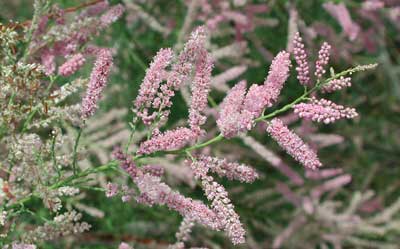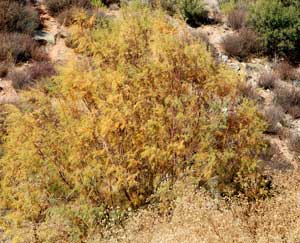Tamarisk
Salt Cedar
Tamarix ramosissima
(T. pentandra)

Despite their attractiveness, the flowers of Tamarisk are not a welcome sight in the Sonoran Desert.
Sponsored Links:
 Tamarisk has scaly, deciduous, needle-like twigs that give the appearance of a
conifer. This is, in fact, an exotic, invasive, flowering plant from southwest
Asia that has come to dominate many riparian areas across the Southwest United
States. It seems to do best in those habitats that have been heavily impacted
by human activities. Irrigation canals and ditches for example. Many of our
formally healthy rivers and streams have been converted in escence to
irrigation ditches: fluctuating water flow from flood to drought without regard
to seasonal norms, heavy contamination from fertilizers and salts, and frequent
disturbance with earthmoving equipment and fires.
Tamarisk has scaly, deciduous, needle-like twigs that give the appearance of a
conifer. This is, in fact, an exotic, invasive, flowering plant from southwest
Asia that has come to dominate many riparian areas across the Southwest United
States. It seems to do best in those habitats that have been heavily impacted
by human activities. Irrigation canals and ditches for example. Many of our
formally healthy rivers and streams have been converted in escence to
irrigation ditches: fluctuating water flow from flood to drought without regard
to seasonal norms, heavy contamination from fertilizers and salts, and frequent
disturbance with earthmoving equipment and fires.
The dense thickets provide cover for wildlife and have been a favored nest site for the endangered the Southwest Willow Flycatcher. Beavers reportedly feed on the twigs and bark, but few native insects feed on the leaves, twigs or nectar. Thus the thickets of tamarisk offer little for foraging birds. Efforts to introduce insects that feed on tamarisk (which would curb the spread and convert some tamarisk biomass into wildlife-friendly food) are opposed by bee keepers because the flowers do provide the imported honey bees.